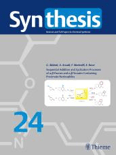
SYNTHESIS-STUTTGART
Scope & Guideline
Connecting Ideas, Catalyzing Innovations in Chemistry.
Introduction
Aims and Scopes
- Innovative Synthetic Methodologies:
The journal emphasizes the development and application of novel synthetic methodologies, including palladium-catalyzed reactions, photoredox catalysis, and organocatalysis, aimed at enhancing efficiency and selectivity in organic synthesis. - Asymmetric Synthesis:
A significant focus is placed on asymmetric synthesis techniques, which are crucial for producing chiral compounds with high enantiomeric purity, particularly for applications in pharmaceuticals and agrochemicals. - Multicomponent Reactions:
The journal highlights advancements in multicomponent reactions that allow for the efficient construction of complex molecular architectures from simple starting materials, thus streamlining synthetic pathways. - Green Chemistry and Sustainability:
There is a growing emphasis on sustainable practices within synthetic chemistry, including the use of green solvents, recyclable catalysts, and environmentally benign processes. - Functionalization of Heterocycles:
The synthesis and functionalization of heterocycles remain a core area, reflecting their importance in drug discovery and material science. - Total Synthesis of Natural Products:
The journal also features studies on the total synthesis of natural products, showcasing the application of synthetic methodologies to create biologically active compounds. - Catalyst Development:
Research on the development of new catalysts, particularly those based on earth-abundant metals, is increasingly relevant, addressing the need for more sustainable catalytic systems.
Trending and Emerging
- Photoredox and Visible-Light Catalysis:
There is a significant increase in research focused on photoredox catalysis, utilizing visible light to drive chemical reactions, which is seen as a sustainable alternative to traditional methods. - Electrochemical Synthesis:
Electrochemical methods are gaining traction as a key area of interest, reflecting a broader trend towards greener synthesis that minimizes solvent use and waste. - Radical Chemistry:
Papers exploring radical chemistry, including radical cyclizations and radical functionalizations, are on the rise, highlighting innovative strategies to construct complex molecules. - Sustainable and Green Chemistry Practices:
An increasing number of publications emphasize sustainable practices, including the use of recyclable catalysts and environmentally friendly reaction conditions. - Multicomponent Reactions and Cascade Processes:
Research on multicomponent reactions and cascade processes is trending, showcasing their efficiency in constructing complex architectures from simple precursors. - Functionalization of Complex Molecules:
There is a growing focus on the functionalization of complex molecules, particularly in medicinal chemistry, which is essential for the development of new therapeutics. - Machine Learning and Computational Chemistry:
The integration of machine learning and computational techniques for predicting reaction outcomes and optimizing synthetic pathways is emerging as a notable trend.
Declining or Waning
- Traditional Reaction Conditions:
There is a noticeable decline in papers focusing on traditional reaction conditions that do not incorporate modern advancements such as green chemistry principles or novel catalytic approaches. - Simplistic Synthesis Techniques:
The journal has seen fewer contributions centered on simplistic or one-dimensional synthesis techniques, as there is a shift towards more complex and multifunctional synthesis strategies. - Conventional Solvent Use:
Papers reporting on conventional solvent use in organic synthesis have decreased, indicating a trend towards solvent-free or green solvent methodologies. - Non-Catalytic Reactions:
There is a waning interest in non-catalytic reactions, as the field increasingly prioritizes catalytic processes that enhance efficiency and reduce waste. - Traditional Natural Product Synthesis:
While the total synthesis of natural products remains relevant, works focusing solely on traditional methods without innovative approaches are appearing less frequently.
Similar Journals
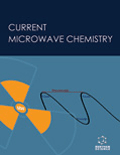
Current Microwave Chemistry
Unleashing the Power of Microwave Technology in ChemistryCurrent Microwave Chemistry is a pioneering academic journal dedicated to the dynamic and rapidly evolving field of microwave-assisted chemistry. Published by Bentham Science Publishers Ltd, this journal aims to disseminate high-quality research that explores innovative methodologies, novel applications, and the fundamental principles underlying microwave technology in chemical processes. Offering a platform for researchers, professionals, and students, Current Microwave Chemistry plays a crucial role in enhancing the understanding and application of microwave chemistry across disciplines such as synthetic chemistry, materials science, and pharmaceutical research. By facilitating open access to groundbreaking studies, this journal encourages collaboration and knowledge exchange, positioning itself as an essential resource for those looking to push the boundaries of what is achievable in chemical science.

RUSSIAN JOURNAL OF ORGANIC CHEMISTRY
Fostering Knowledge in Organic Chemistry DynamicsRUSSIAN JOURNAL OF ORGANIC CHEMISTRY, published by MAIK NAUKA/INTERPERIODICA/SPRINGER, stands as a pivotal resource in the realm of organic chemistry, catering to an audience of researchers, professionals, and students keen on the latest advancements in this dynamic field. With an ISSN of 1070-4280 and E-ISSN of 1608-3393, this journal has been a fixture in academic literature since its inception in 1996 and continues to play a significant role as it converges towards 2024. Despite currently holding a Q4 ranking in organic chemistry and a modest placement in the Scopus ranks, the journal offers valuable insights and contributions that reflect the ongoing research and trends within the discipline. Though it does not operate under an open access model, the journal provides essential studies and reviews that enhance scientific dialogue and innovation. Located in the United States, the journal supports the advancement of organic chemistry, fostering a deeper understanding of complex chemical interactions and methodologies.
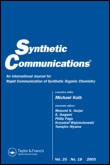
SYNTHETIC COMMUNICATIONS
Connecting Innovators in the World of Organic SynthesisSynthetic Communications, published by Taylor & Francis Inc, stands as a pivotal resource in the field of organic chemistry since its inception in 1971. With an ISSN of 0039-7911 and an E-ISSN of 1532-2432, this journal has established a commendable reputation, holding a Q3 ranking in organic chemistry by 2023, reflecting its contributions to the discipline and positioning it within the 50th percentile according to Scopus rankings. Targeted towards researchers, professionals, and students alike, Synthetic Communications aims to disseminate significant advancements in synthetic methodologies and reactions, facilitating the exchange of innovative ideas and enhancing collaborative efforts in the scientific community. Although not an open-access journal, it offers a wealth of valuable research content that is crucial for anyone dedicated to pushing the boundaries of organic chemistry.
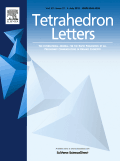
TETRAHEDRON LETTERS
Advancing the Frontiers of Chemical KnowledgeTETRAHEDRON LETTERS, published by Pergamon-Elsevier Science Ltd, is a leading journal in the fields of Biochemistry, Drug Discovery, and Organic Chemistry, with a rich legacy since its inception in 1959. This prestigious journal serves as a vital resource for researchers and professionals dedicated to advancing the understanding of chemical sciences, featuring high-impact research that influences both academic and practical applications. Although it is currently classified in the third quartile across its categories for 2023, its rigorous peer-review process ensures the publication of quality research that contributes to the scientific community. With an ISSN of 0040-4039 and an E-ISSN of 1873-3581, TETRAHEDRON LETTERS is easily accessible for those in the academic landscape seeking to stay abreast of innovative developments. Researchers, professionals, and students alike will find invaluable insights and collaborative opportunities within the pages of TETRAHEDRON LETTERS, making it an essential read for anyone involved in the chemical sciences.
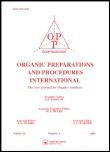
ORGANIC PREPARATIONS AND PROCEDURES INTERNATIONAL
Advancing Organic Synthesis Through Innovative MethodologiesORGANIC PREPARATIONS AND PROCEDURES INTERNATIONAL is a prominent journal in the field of organic chemistry, published by Taylor & Francis Inc. With an ISSN of 0030-4948 and an E-ISSN of 1945-5453, this journal has been a vital resource for researchers since its inception in 1971, showcasing a broad range of methodologies, protocols, and innovative applications within organic synthesis. Although categorized in the Q4 quartile for organic chemistry, the journal provides a critical platform for researchers at all levels to disseminate their findings and to access a wealth of practical organic procedures. It currently ranks #151 out of 211 in the Scopus Organic Chemistry category, underscoring its role in advancing the discipline despite its relatively modest impact factor. The journal offers a diverse collection of scholarly articles that are essential for both professional chemists and students, enriching their understanding of organic preparation techniques. Inviting contributions that encompass the full spectrum of organic synthesis, this journal serves as a valuable conduit for knowledge exchange in the ever-evolving field of organic chemistry.

JOURNAL OF HETEROCYCLIC CHEMISTRY
Fostering Insight in Chemical ComplexityJournal of Heterocyclic Chemistry, published by Wiley, stands as a key resource in the field of organic chemistry, offering in-depth research articles and insights spanning from 1966 to 2024. With its strong Scopus ranking of #83 out of 211 in the Organic Chemistry category, placing it in the 60th percentile, the journal maintains its significance and relevance within the academic community. Although it does not currently offer open access options, it provides extensive coverage of heterocyclic compounds, which are vital to various applications in pharmaceuticals and material sciences. The journal's commitment to high-quality research is further reflected in its classification as Q3 in the 2023 quartiles for Organic Chemistry. Researchers, professionals, and students alike will find valuable contributions to the intricate studies of heterocycles, enhancing their understanding and exploration of this fascinating area of chemistry.
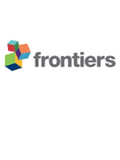
Frontiers in Chemistry
Unleashing Potential in Chemistry for a Brighter Future.Frontiers in Chemistry is an esteemed and innovative Open Access journal published by FRONTIERS MEDIA SA, based in Lausanne, Switzerland. Since its inception in 2013, the journal has established itself as a leading platform for the dissemination of high-quality research across a broad spectrum of chemistry disciplines, achieving a notable Q1 classification in the miscellaneous chemistry category as of 2023. With an impressive Scopus rank, placing it at 72nd out of 408 in General Chemistry and falling within the 82nd percentile, Frontiers in Chemistry is committed to publishing significant findings that contribute to the advancement of the field. The journal's Open Access model ensures that research is freely accessible to all, fostering a greater exchange of knowledge and collaboration among researchers, professionals, and students globally. It covers a range of topics, from organic and inorganic chemistry to materials science and biochemistry, making it an essential resource for anyone seeking to stay at the forefront of chemical research.
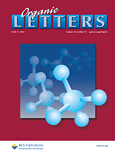
ORGANIC LETTERS
Leading the Charge in Organic Chemistry InnovationOrganic Letters is a leading peer-reviewed journal dedicated to the rapid dissemination of research in the field of organic chemistry. Published by the American Chemical Society, this esteemed journal has been an invaluable resource for researchers and professionals since its inception in 1999, featuring research articles that contribute significantly to the understanding of organic synthesis and related disciplines. With its impressive impact factor, it is currently ranked in the top quartile (Q1) across multiple categories, including Biochemistry, Organic Chemistry, and Physical and Theoretical Chemistry, showcasing its influence in the scientific community. The journal's commitment to quality is underscored by its high rankings in Scopus, placing it among the top tier of journals in its categories. While not an open-access journal, Organic Letters offers exceptional access options for institutions and individuals seeking cutting-edge research. As it continues to evolve towards its convergence year of 2024, it remains the go-to publication for innovative findings and methodologies in organic chemistry.

RUSSIAN JOURNAL OF GENERAL CHEMISTRY
Bridging Disciplines Through Rigorous Chemistry InsightsThe Russian Journal of General Chemistry is a prominent scholarly publication dedicated to advancing the field of general chemistry. Published by MAIK NAUKA/INTERPERIODICA/SPRINGER, this journal contributes significantly to the global chemistry landscape, offering a platform for researchers and professionals to share their latest findings and methodologies. With an ISSN of 1070-3632 and an E-ISSN of 1608-3350, it has established itself as a resource for high-quality research articles since its inception in 1996. Though currently indexed in the Q4 category for chemistry (miscellaneous) and ranking #299 out of 408 in general chemistry according to Scopus, the journal remains an important venue for academic contributions that bridge gaps in traditional chemical disciplines. Desiring to cater to a diverse range of interests within chemistry, the journal actively encourages submissions that reflect significant scientific achievements, innovations, and collaborative studies. Although the journal does not currently offer open access, its role in disseminating crucial chemical research cannot be overstated. Researchers and students alike will find valuable insights and rigorous scientific discourse in its pages.

Heterocyclic Letters
Pioneering Discoveries in Medicinal and Agricultural ChemistryHeterocyclic Letters is an esteemed journal in the field of synthetic organic chemistry, published by RAMAN PUBL. With ISSN 2231-3087 and E-ISSN 2230-9632, this journal aims to disseminate original research and innovative findings related to heterocyclic compounds, which play a crucial role in medicinal chemistry, material science, and agricultural chemistry. Heterocyclic Letters provides a platform for researchers, professionals, and students to share their insights and advancements, thus fostering academic collaboration and knowledge transfer. The journal is dedicated to maintaining high-quality standards in research publication, making it an essential resource for anyone focused on the latest developments in heterocyclic chemistry. Although it does not currently offer Open Access options, the journal’s rigorous peer-review process ensures that only the most credible and impactful studies are published, contributing significantly to the advancement of the field.